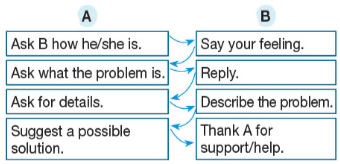Tiếng Anh 11 Bright Unit 1 1d. Speaking1. Listen and repeat. Match the statements (a-f) to the teenage problems (1-6). 2. a) Listen and read the dialogue. What are the girls talking about? b) Which of the underlined phrases/ sentences are asking about a problem? complaining? Think of more similar phrases/ sentences. 3. Act out a dialogue similar to the one in Exercise 2a. Use the diagram below. Mind the information and rhythm. 4. Listen and mark the correct intonation. Then listen and repeat. Practice saying them.
Lựa chọn câu để xem lời giải nhanh hơn
Bài 1 Vocabulary Teenage problems (Các vấn đề của thanh thiếu niên) 1. Listen and repeat. Match the statements (a-f) to the teenage problems (1-6). (Lắng nghe và lặp lại. Nối các câu (a-f) với các vấn đề của thanh thiếu niên (1-6).)
a. “My best friend and I are not talking.” b. “I’m always arguing with my parents.” c. “I don’t care about the rules.” d. “I don’t know what to do after graduation.” e. “I hate looking at myself in the mirror!” f. “I am so stressed about my grades.” Phương pháp giải: - body image: tự cảm nhận cơ thể - school performance: thành tích giáo dục - future career: nghề nghiệp tương lai - friends and relationships: bạn bè và các mối quan hệ - family problems: vấn đề gia đình - attitude and behaviour: thái độ và hành vi Lời giải chi tiết:
1. e: body image – “I hate looking at myself in the mirror!” (tự cảm nhận cơ thể - “Tôi ghét nhìn bản thân mình trong gương!”) 2. f: school performance – “I am so stressed about my grades.” (thành tích giáo dục – “Tôi rất căng thẳng về điểm số của mình.”) 3. d: future career – “I don’t know what to do after graduation.” (nghề nghiệp tương lai – “Tôi không biết phải làm gì sau khi tốt nghiệp.”) 4. a: friends and relationships – “My best friend and I are not talking.” (bạn bè và các mối quan hệ - “Bạn thân và tôi đang không nói chuyện với nhau.”) 5. b: family problems – “I’m always arguing with my parents.” (vấn đề gia đình – “Tôi luôn luôn tranh cãi với bố mẹ.”) 6. c: attitude and behaviour – “I don’t care about the rules.” (thái độ và hành vi – “Tôi không quan tâm về những quy tắc.”) Bài 2 a Everyday English Complaining (Việc phàn nàn) 2a) Listen and read the dialogue. What are the girls talking about? (Nghe và đọc đoạn đối thoại. Các cô gái đang nói về cái gì?) Sarah: Hey! What's up? Kelly: I'm so upset. Sarah: What's wrong? Kelly: Susan is driving me crazy! We had a big fight and now she is not talking to me. Sarah: What happened? Kelly: She thinks I don't want to go to her party on Saturday. I can't go because it's my mum's birthday. Now she hates me. Sarah: Cheer up! We can go and see her at school tomorrow and explain everything. Kelly: OK. Thank you. Phương pháp giải: Sarah: Này! Có chuyện gì vậy? Kelly: Tôi đang rất buồn. Sarah: Có chuyện gì vậy? Kelly: Susan đang khiến tôi phát điên! Chúng tôi đã có một cuộc chiến lớn và bây giờ cô ấy không nói chuyện với tôi. Sarah: Chuyện gì đã xảy ra vậy? Kelly: Cô ấy nghĩ tôi không muốn đến bữa tiệc của cô ấy vào thứ bảy. Tôi không thể đi vì đó là sinh nhật của mẹ tôi. Bây giờ cô ấy ghét tôi. Sarah: Vui lên đi! Chúng ta có thể đến gặp cô ấy ở trường vào ngày mai và giải thích mọi chuyện. Kelly: Được thôi. Cảm ơn nha. Lời giải chi tiết: The girls are talking about the argument between Kelly and Susan. (Các cô gái đang nói về cuộc tranh cãi giữa Kelly và Susan.) Bài 2 b b) Which of the underlined phrases/ sentences are asking about a problem? complaining? Think of more similar phrases/ sentences. (Những cụm từ/ câu được gạch chân nào đang hỏi về một vấn đề hay phàn nàn? Nghĩ thêm những cụm từ/câu tương tự.) Lời giải chi tiết: These underlined phrases/ sentences are asking about a problem: (Những cụm từ/câu được gạch chân này đang hỏi về một vấn đề) - What's wrong? (Có chuyện gì vậy?) - What happened? (Chuyện gì đã xảy ra?) Similar phrases: (Những cụm tương tự) - How’s it going? (Mọi việc sao rồi?) These underlined phrases/ sentences are complaining: (Những cụm từ/câu được gạch chân này đang phàn nàn) - I'm so upset. (Tôi rất buồn.) - Susan is driving me crazy! (Susan khiến tôi phát điên lên!) Similar phrases: (Những cụm tương tự) - She is always talking in class. (Cô ấy luôn nói chuyện trong lớp.) - I’m not satisfied with his attitude. (Tôi không hài lòng với thái độ của anh ấy.) Bài 3 3. Act out a dialogue similar to the one in Exercise 2a. Use the diagram below. Mind the information and rhythm. (Thực hiện một đoạn hội thoại tương tự như trong Bài tập 2a. Sử dụng sơ đồ dưới đây. Chú ý thông tin và nhịp điệu.)
Phương pháp giải: 1. A hỏi B khỏe không. 2. B nói cảm giác của mình. 3. A hỏi có vấn đề gì. 4. B trả lời. 5. A hỏi chi tiết hơn. 6. B mô tả vấn đề. 7. A đề xuất giải pháp khả thi. b. B cảm ơn A vì đã giúp đỡ/ hỗ trợ. Lời giải chi tiết: A: Hey! What's up? (Này! Có chuyện gì vậy?) B: I'm so sad. (Tôi đang rất buồn.) A: What's wrong? (Có chuyện gì vậy?) B: My mom makes me crazy! We had a big argument and now she is not talking to me. (Mẹ tôi làm tôi phát điên! Chúng tôi đã có một cuộc tranh cãi lớn và bây giờ bà ấy không nói chuyện với tôi.) A: What happened? (Chuyện gì đã xảy ra vậy?) B: She thinks I don't try my best to get high scores. Actually, I have made an effort to learn as much as possible but I can’t. (Bà ấy nghĩ tôi không cố gắng hết sức để đạt điểm cao. Thật ra, tôi đã nỗ lực học tập rất nhiều nhưng tôi không thể.) A: Don’t worry! You need to explain everything and your mom will then understand. (Đừng lo lắng! Bạn cần phải giải thích mọi thứ và mẹ của bạn sẽ hiểu thôi.) B: OK. Thank you. (Được thôi. Cảm ơn nha.) Bài 4 Pronunciation Intonation in Wh-questions and Yes/No questions (Ngữ điệu trong câu hỏi Wh và câu hỏi Yes/No) 4. Listen and mark the correct intonation. Then listen and repeat. Practice saying them. (Nghe và đánh dấu đúng ngữ điệu. Sau đó nghe và lặp lại. Thực hành nói chúng.) 1. What’s up? 2. Is everything OK? 3. Do you need any help? 4. Are you ready? 5. What’s wrong? Phương pháp giải: Trong câu hỏi dạng -Wh, ngữ điệu thường đi xuống. Trong câu hỏi dạng Yes – No, ngữ điệu thường đi lên. Lời giải chi tiết: 1. What’s up? ↘ (Có chuyện gì vậy?) Giải thích: câu hỏi dạng -Wh => ngữ điệu thường đi xuống. 2. Is everything OK? ↗ (Mọi thứ ổn chứ?) Giải thích: câu hỏi dạng Yes/No => ngữ điệu thường đi lên. 3. Do you need any help? ↗ (Bạn có cần giúp đỡ gì không?) Giải thích: câu hỏi dạng Yes/No => ngữ điệu thường đi lên. 4. Are you ready? ↗ (Bạn đã sẵn sàng chưa?) Giải thích: câu hỏi dạng Yes/No => ngữ điệu thường đi lên. 5. What’s wrong? ↘ (Có chuyện gì vậy?) Giải thích: câu hỏi dạng -Wh => ngữ điệu thường đi xuống.
|















